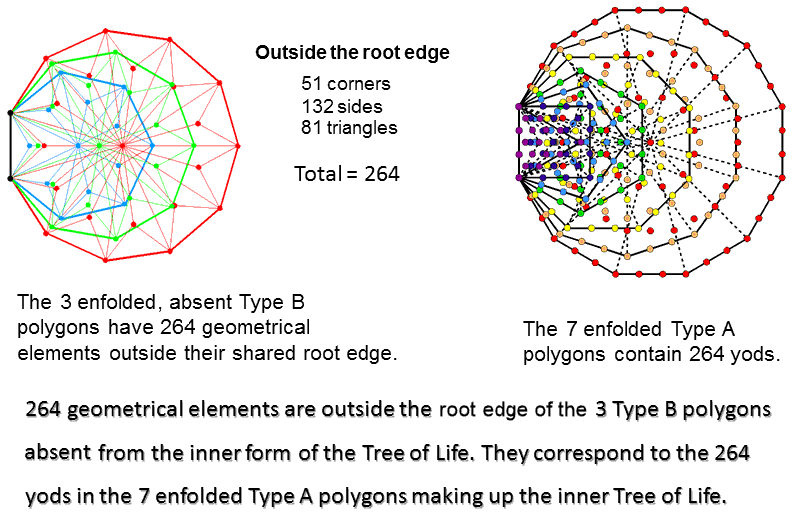
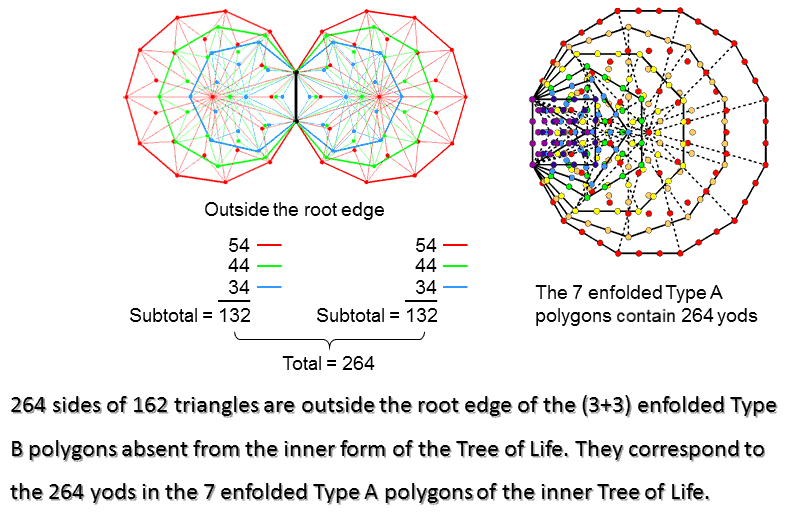
| << Previous 1... 11 12 [13] 14 15 ...17 Next >> |
#13 The Holistic Pattern
As we have just seen, the Godnames of the 10 Sephiroth mathematically prescribe the geometrical and yod composition of the three regular polygons that are absent from the inner form of the Tree of Life. Discounting the absurdity that this could be due to chance implies that the analogy between the 3:7 division of Sephiroth and the 3:7 division in the first 10 types of polygons is more than just a formal one. The three absent polygons must, together, constitute a holistic system. This means that they should express the basic pattern that is characteristic of such systems, as discussed at length in The holistic pattern. This will be verified later.
As a remarkable example of how the three polygons display holistic parameters, Table 2 indicates that they comprise 267 corners, sides & triangles when enfolded and Type B. Therefore, (267−3=264) geometrical elements are outside their root edge. This number is embodied in the inner Tree of Life as the 264 yods in the 7 enfolded Type A polygons constructed from tetractyses:
 |
 |
According to Table 2, the three enfolded polygons have 133 sides, so that the 264 geometrical elements include 132 sides and 132 corners & sides. This 132:132 division corresponds in the 7 enfolded Type A polygons as the 132 yods in the triangle, square, pentagon & dodecagon outside the root edge and the 132 yods in the hexagon, octagon & decagon (see Table 5 in Article 64). Outside the root edge of the (3+3) enfolded Type B polygons are (132+132=264) sides of (81+81=162) triangles. This is another way in which the (3+3) enfolded polygons embody a Tree of Life parameter.
Sacred geometries (including the 64 hexagrams used in the I Ching system of divination) display the following pattern of numbers:
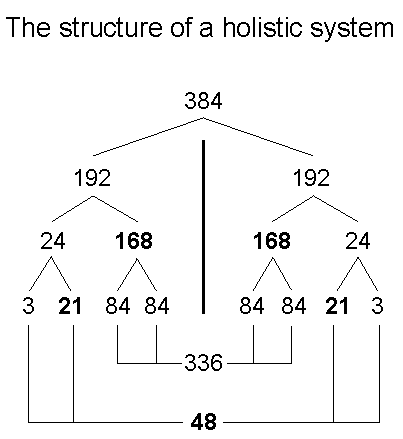
It is illustrated widely throughout this website. Inspection of Table 2 reveals that the three separate Type B polygons have 192 corners & sides. This means that the two sets of three separate Type B polygons (one set the mirror image of the other) have (192+192=384) corners & sides. The counterpart of this in the (7+7) separate Type A polygons is the (192+192=384) corners, sides & triangles that surround their centres:
|
|
|
Above and below the horizontal axis passing through the centres of each set of three polygons are 24 corners (12 black, 12 white). This leaves 33 red or blue corners and 135 red or blue sides, i.e., 168 corners & sides. This 24:168 division in the number 192 is a primary feature of this parameter of holistic systems. It exists in the seven separate Type A polygons as the 24 geometrical elements surrounding the centre of the hexagon (the fourth regular polygon) and the 168 geometrical elements surrounding the centres of the six other polygons when they are all divided into sectors. The 3:21 division in each set of 24 corners manifests as the three corners (black or white) in the heptagon above or below the axis and the 21 other corners. The 84:84 division of 168, which, as many pages in this website reveal, emerges as fundamental to the 3-dimensional structure of E8×E8 heterotic superstrings, manifests in the three separate polygons as follows: the 27 sectors of each set of three polygons have 54 sides and 27 internal corners, totalling 81 sides & corners. Including the three centres, there are 84 internal corners & sides of 27 sectors. The three triangles in a sector have three internal sides, so that the 81 triangles have 81 more internal sides. Including the three corners on the axis, there are 84 internal sides & corners. Hence, the 168 corners & sides consist of 84 internal corners & sides and 84 more corners & internal sides.
The number of yods in an n-gon with 2nd-order tetractyses as its sectors = 72n + 1, where "1" denotes its centre. The number of yods in the three separate polygons with 27 corners = 3 + 72×27 = 1947. Construction of the three polygons with 27 corners from 2nd-order tetractyses requires (1947−27=1920=192×10) more yods. The holistic parameter 192 is embodied in each set of three polygons as the number of yods in 192 tetractyses needed to transform their sectors into 2nd-order tetractyses. The number 1920 can be represented as a five-fold array of the squares of the nine integers 2-10:
1920 = 5(22 + 32 + 42 + 52 + 62 + 72 + 82 + 92 + 102).
Noting that 13 yods line each side of a 2nd-order tetractys, the number of yods in the three enfolded polygons with 2nd-order tetractyses as their sectors = 1947 − 13 − 13 = 1921. This can be represented by a five-fold array of the squares of the 10 integers 1-10, with 12 at its centre. It is composed of 46 squares. This beautiful property reveals the hidden role of the Decad (10) in determining parameters of the three polygons associated with the Supernal Triad.
As a holistic system, the three polygons absent from the inner Tree of Life embody the various mathematical patterns displayed by the outer Tree of Life. This is illustrated below:
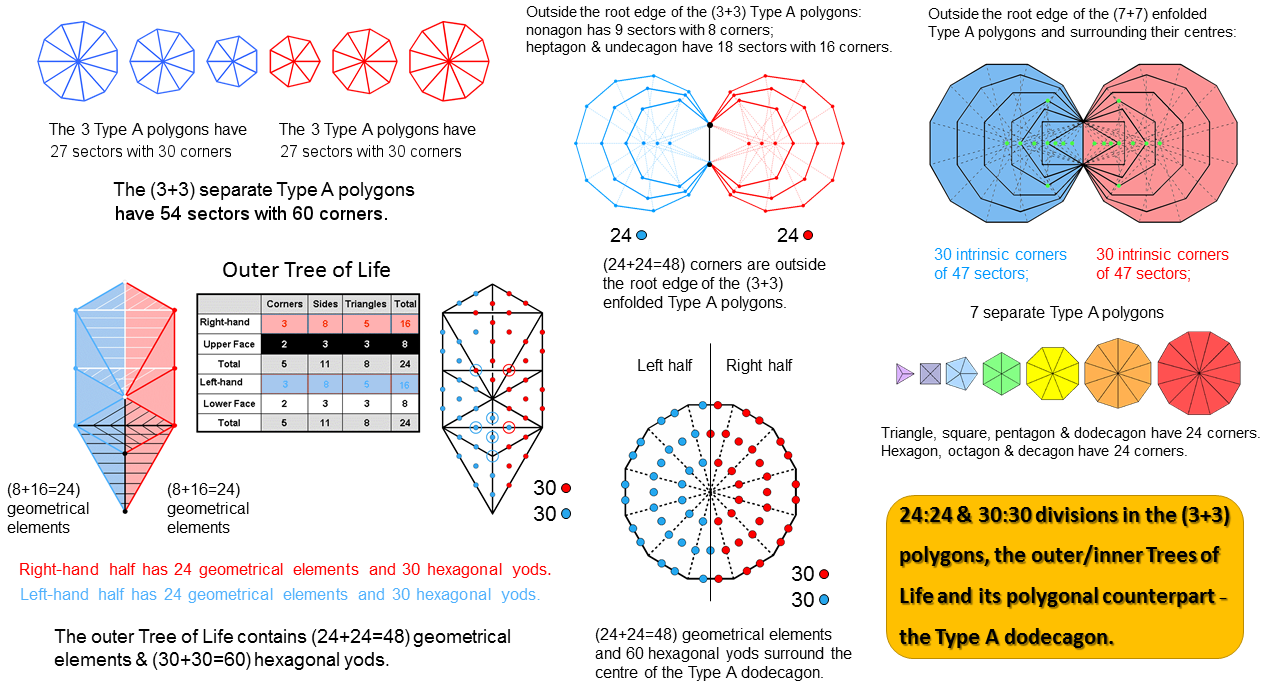
|
Intuitively, this is what should be expected, given that the seven Sephiroth of Construction emanate from the Supernal Triad, so that the various patterns within the seven polygons that represent the former should have originated from analogous patterns within the three polygons that represent the latter. The following comments are required:
According to Table 2, the three enfolded Type B polygons have 400 yods. The number of yods lining their 81 tetractyses = 400 − 81 = 319. The number of yods outside their root edge and surrounding their centres = 319 − 4 − 3 = 312. The (3+3) enfolded Type B polygons have (312×2=624) such boundary yods. The number of hexagonal yods in a 2nd-order n-gon = 13n. The seven Type B polygons in the inner Tree of Life with 48 corners have (13×48=624) hexagonal yods:
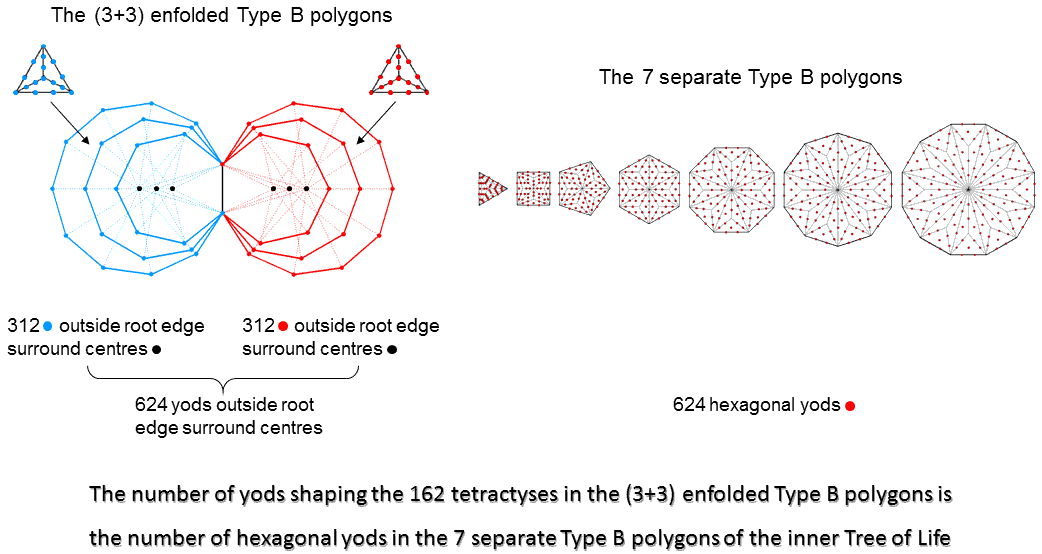 |
The number of yods needed to shape the boundaries of the 162 tetractyses in the (3+3) enfolded Type B polygons is exactly the same as the number of hexagonal yods in the seven separate Type B polygons. Here is a spectacular example of how the archetypal numbers or holistic parameters embodied in the three polygons analogous to the Supernal Triad manifest in the polygons analogous to the seven Sephiroth of Construction. We may regard the three polygons in the first 10 polygons that are absent from the inner Tree of Life as their more abstract precursor. They are prescribed by the Godnames and embody patterns and numbers analogous to that found in sacred geometries because — despite their difference in appearance —they possess the miraculous property of being equivalent in a mathematical way to these geometries, e.g., the outer and inner Trees of Life. Of course, we mean 'remarkable,' not literally 'miraculous,' because there are perfectly simple, arithmetic reasons for this equivalence, as will be explained later.